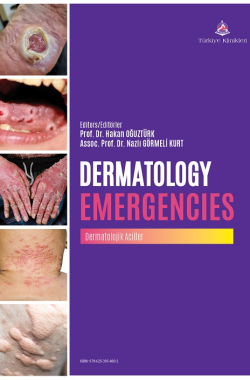Streptococcal Toxic Shock Syndrome
Talat Cem ÖZDEMİR
Şanlıurfa Ceylanpınar Public Hospital, Clinic of Emergency Medicine, Şanlıurfa, Türkiye
Nurullah İshak IŞIK
Ankara Etlik City Hospital, Clinic of Emergency Medicine, Ankara, Türkiye
Özdemir TC, Işık Nİ. Streptococcal toxic shock syndrome. In: Oğuztürk H, Görmeli Kurt N, eds. Dermatologic Emergencies. 1st ed. Ankara: Türkiye Klinikleri; 2025. p.69-74.
ABSTRACT
Group A Streptococcus (GAS) is a Gram-positive bacterium commonly found in the normal flora and can lead to various infections. In addition to frequently encountered infections in the pharynx, it can cause invasive infections such as necrotizing soft tissue infections, bacteremia, and respiratory tract infections. A complication of these invasive infections is the development of Streptococcal Toxic Shock Syndrome (STSS). STSS occurs due to the production of GAS superantigens (Sags), which activate T cells, leading to an inflammatory response and hypotension. Globally, invasive GAS infections account for approximately 1.8 million cases, with STSS occurring in one-third of these cases. The mortality rate of STSS in adults ranges from 30-70%, while it is lower in children. Risk factors include minor trauma, NSAID use, immunosuppression, and obesity. Clinical manifestations are typically nonspecific and may present with influenza-like symptoms, hypotension, and organ failure. Diagnosis is based on CDC criteria and confirmed through GAS isolation. Management of STSS requires a multidisciplinary approach. Early diagnosis and antibiotic treatment are crucial. In cases requiring intensive care, fluid resuscitation and vasopressor support are provided. Additionally, identifying the source of infection and performing surgical intervention when necessary is important. The use of intravenous immunoglobulin (IVIG) is recommended to mitigate the effects of GAS.
Keywords: Emergencies; streptococcus; shock, septic; toxic shock syndrome toxin 1
Kaynak Göster
Referanslar
- Ferretti JJ, Stevens DL, Fischetti VA, editors. Streptococcus pyogenes : Basic Biology to Clinical Manifestations [Internet]. Oklahoma City (OK): University of Oklahoma Health Sciences Center; 2016-. Available from: [Link]
- Cone LA, Woodard DR, Schlievert PM, Tomory GS. Clinical and bacteriologic observations of a toxic shock-like syndrome due to Streptococcus pyogenes. N Engl J Med. 1987;317(3):146-9. [Crossref] [PubMed]
- Annane D, Clair B, Salomon J. Managing toxic shock syndrome with antibiotics. Expert Opin Pharmacother. 2004;5(8):1701-10. [Crossref] [PubMed]
- Waddington CS, Snelling TL, Carapetis JR. Management of invasive group A streptococcal infections. J Infect. 2014;69 Suppl 1:S63-9. [Crossref] [PubMed]
- Hansen NS, Leth S, Nielsen LT. Toksisk shock-syndrom. Ugeskr Læger. 2020;182:V11190673. [Link]
- Massese M, La Sorda M, De Maio F, Gatto A, Rosato R, Pansini V, et al. Epidemiology of group A streptococcal infection: are we ready for a new scenario? Lancet Microbe. 2024;5(7):620-1. [Crossref] [PubMed]
- Newberger R, Gupta V. Streptococcus Group A. [Updated 2023 Feb 6]. In: StatPearls [Internet]. Treasure Island (FL): StatPearls Publishing; 2024 Jan-. Available from: [Link]
- Stevens DL, Bryant AE. Severe Group A Streptococcal Infections. 2016 Feb 10. In: Ferretti JJ, Stevens DL, Fischetti VA, editors. Streptococcus pyogenes: Basic Biology to Clinical Manifestations [Internet]. Oklahoma City (OK): University of Oklahoma Health Sciences Center; 2016-. Available from: [Link]
- Burnham JP, Kollef MH. Understanding toxic shock syndrome. Intensive Care Med. 2015;41(9):1707-10. [Crossref] [PubMed]
- Ben-Abraham R, Keller N, Vered R, Harel R, Barzilay Z, Paret G. Invasive group A streptococcal infections in a large tertiary center: epidemiology, characteristics and outcome. Infection. 2002;30(2):81-5. [Crossref] [PubMed]
- Shah SS, Hall M, Srivastava R, Subramony A, Levin JE. Intravenous immunoglobulin in children with streptococcal toxic shock syndrome. Clin Infect Dis. 2009;49(9):1369-76. [Crossref] [PubMed] [PMC]
- Górka J, Skupnik W, Mikiewicz M, Szwajca K, Haładus K, Szczeklik W, et al. Rapidly progressive streptococcal toxic shock syndrome epidemic in Kraków, 2023. PAIM. 2023;133(11):16570. [Crossref]
- Bartoszko JJ, Elias Z, Rudziak P, Lo CKL, Thabane L, Mertz D, et al. Prognostic factors for streptococcal toxic shock syndrome: systematic review and meta-analysis. BMJ Open. 2022;12(12):e063023. [Crossref] [PubMed] [PMC]
- Stevens DL, Tanner MH, Winship J, Swarts R, Ries KM, Schlivert PM, et al. Severe group A streptococcal infections associated with a toxic shock-like syndrome and scarlet fever toxin A. N Engl J Med. 1989;321(1):1-7. [Crossref] [PubMed]
- Deutscher M, Schillie S, Gould C, Baumbach J, Mueller M, Avery C, et al. Investigation of a group A streptococcal outbreak among residents of a longterm acute care hospital. Clin Infect Dis. 2011;52(8):988-94. [Crossref] [PubMed]
- Schmitz M, Roux X, Huttner B, Pugin J. Streptococcal toxic shock syndrome in the intensive care unit. Ann Intensive Care. 2018;8(1):88. [Crossref] [PubMed] [PMC]
- Agerson AN, Wilkins EG. Streptococcal toxic shock syndrome after breast reconstruction. Ann Plast Surg. 2005;54(5):553-6. [Crossref] [PubMed]
- Lappin E, Ferguson AJ. Gram-positive toxic shock syndromes. The Lancet Infectious Diseases. 2009;9(5):281-90. [Crossref] [PubMed]
- Control CfD, Prevention. Streptococcal toxic shock syndrome (STSS)(Streptococcus pyogenes) 2010 case definition. CDC: Atlanta, GA, USA. 2010. [Link]
- Linnér A, Darenberg J, Sjölin J, Henriques-Normark B, Norrby-Teglund A. Clinical efficacy of polyspecific intravenous immunoglobulin therapy in patients with streptococcal toxic shock syndrome: a comparative observational study. Clin Infect Dis. 2014;59(6):851-7. [Crossref] [PubMed]

